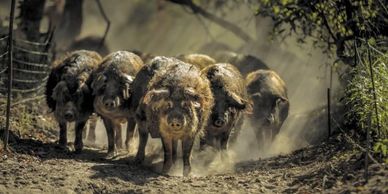Our pig - 100% pure mangalitsa
The Farms
The Farms
The Farms

When he was in California, Tony sourced Mangalitsa hogs from Winkler Farms who is dedicated to upholding the integrity of the breed and each animal through selective-genetic breeding to ensure the utmost quality in generations of hogs to follow. The farm was awarded 4 out of 5 stars for genetic purity, breed standards, and traits by the Hungarian National Association of Mangalica Breeders.
Now, mainly sourcing from Eltee Mangalitsa Gourmet Pork; a family farm in Pender, Nebraska that began raising Mangalitsa hogs in 2014. The farm is operated by husband and wife, Leon and Tami Svoboda and they are applaudingly up to standard on preserving lineage, breed purity, and practicing selective genetic breeding.
The Breed
The Farms
The Farms

Mangalitsa (mahn-ga-leetz-ah), meaning "hog with a lot of lard," is a noble Hungarian breed that arrived in America in 2007. Known for its rich, dark meat that resembles premium beef, heavy intramuscular marbling, and silky fat, the Mangalitsa is known the "Kobe of Pork." It is for this reason that Tony coined the term “AVANT-LARD'E”
Often compared to premium beef in terms of color and cooked flavor, Mangalitsa pork shines in a category of its own as a luxurious meat without comparison. Due to its high fat content, Mangalitsa is ideal for premium charcuterie.
The Dream
The Farms
The Dream

Tony Incontro, founder of INCONTRO CURED, holds himself to high expectations. His motto is “simplicity and purity,” reinforcing his desire to ensure the purity of the Mangalitsa breed. Tony commits himself to evolving the breed’s unique attributes and spread its reputation as an honest, world-class pork and cured product.
His vision is to create genuine and pure products that originate from the United States of America. This is his dream – one premium breed, one farm, one craftsman.
Current News

INCONTRO Cured Family Farm
Tony also raises his own Mangalitsa pigs on his family farm in Fort Calhoun, Nebraska pioneering the concept of owning a farm operation which is directly funneled into a USDA salumi production. This is the true old-world artisan style that Tony strongly believes in. The process of understanding and meticulously refining selective breeding and farming practices, encourages his growth to become even more well-rounded in the art and craft of salumi.
The Incontro estate Farm spans through acres of lively woodlands where the Mangalitsa hogs roam about, free to root around and live in their natural habitat. There are also covered shelters for farrowing and bedding where the animals can come and go as they please, and where they also take shelter from the extreme weather conditions in Nebraska.
Breed Facts

History and Attributes
The Mangalitsa breed verged on the brink of extinction in the 1900s due to the rising popularity of inexpensive, processed vegetable oils and lard substitutes. Widespread postulations that animal fat causes diseases and ill health caused their numbers to diminish to less than 200 pigs globally. It was not a good time to be known as a "lard breed."
So, how did the noble Mangalitsa make a triumphant comeback?
It was in no small part due to the excellent cured meat products they produce. Deliciously silky and succulent, they swiftly became highly sought-after. In the early 2000s, the Mangalitsa breed made a slow but strong resurgence in the early 2000s through the combined efforts of a Hungarian geneticist, local farmers, and European ham producers.
At the same time, the growing appreciation of natural foods and healthy living continues to elevate the popularity of the Mangalitsa. Health-conscious consumers became aware of the different kinds of healthy fats our body needs, and they turned to Mangalitsa pork for the consistently high quality it brings to the table.
Mangalitsa's distinctive qualities are its curly, sheep-like wool and intensely intramuscular fat-streaked meat high in fat content (up to 70%) with a superb fatty acid composition. They come in three varieties: Blond, Swallow-Bellied, and Red Mangalitsa. Color aside, they are virtually identical with slight differences in the meat, marbling, and fat qualities. Mangalitsa meat belongs to the group of fat-rich meat. When fresh, it is considerably darker, more succulent, and more delicate than the meat of other well-known heritage pig breeds.
It is widely accepted that the Lápi pig breed, kept by the Avar people (a.d. 800-900), from the Carpathian basin, might have been the predecessor of Mangalica breed group; Bakony, Szalonta, Alföldi (EGERSZEGI et al., 2003). Mangalitsa is considered the only surviving autochthonous breed in Serbia, attesting to its pure-bred lineage and high quality.
Mangalitsa takes longer to reach maturity, around 15 months, far exceeding the average commodity pork growth rate (6-8 months) under the care of large-scale industrial farming methods. We believe in doing right by the animal and respecting old traditional ways of farming. Harvest is at 18 to 24 months because we take the extra time to ensure each hog develops steadily and matures to its full potential.